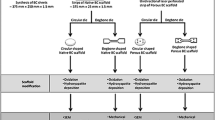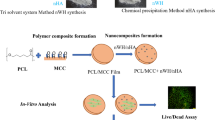Abstract
The study of inorganic hydroxyapatite (HA) assembly in polymer matrix is of great interest in bone tissue engineering field. An in situ synthesis method is employed in this study to synthesise carboxymethyl cellulose (CMC)/HA composite scaffolds to mimic the natural bone. The formation of HA in CMC matrix is initiated at three different temperature (30 °C, 60 °C and 90 °C) and the size of HA decreased with the increase of temperature. The morphology of the scaffolds as viewed by scanning electron microscope shows the formation of rough surfaces with agglomerated HA that can favour appreciable attachment of cells. The X-ray diffraction and Fourier transform infrared spectroscopy confirmed the purity of the formed HA in the polymer matrix. The mechanical properties of the scaffolds reveal that they can form suitable templates to support newly formed bone cells at the site of the defect. The cytotoxicity test of scaffolds with the fibroblast (NIH3T3) cells demonstrated that they can form a suitable template for the attachment of cells and proliferation in bone regeneration.

ᅟ







Similar content being viewed by others
References
Hosseinkhani M, Mehrabani D, Karimfar MH, Bakhtiyari S, Manafi A, Shirazi R (2014) Tissue engineered scaffolds in regenerative medicine. World J Plast Surg 3:3–7
Henkel J, Woodruff MA, Epari DR, Steck R, Glatt V, Dickinson IC, Choong PFM, Schuetz MA, Hutmacher DW (2013) Bone regeneration based on tissue engineering conceptions—a 21st century perspective. Bone Res 1:216–248
Amini AR, Laurencin CT, Nukavarapu SP (2012) Bone tissue engineering: recent advances and challenges. Crit Rev Biomed Eng 40:363–408
Campana V, Milano G, Pagano E, Barba M, Cicione C, Salonna G, Lattanzi W, Logroscino G (2014) Bone substitutes in orthopaedic surgery: from basic science to clinical practice. J Mater Sci Mater Med 25:2445–2461
Gruskin E, Doll BA, Futrell FW, Schmitz JP, Hollinger JO (2012) Demineralized bone matrix in bone repair: history and use. Adv Drug Del Rev 64:1063–1077
O'Brien FJ (2011) Biomaterials & scaffolds for tissue engineering. Mater Today 14:88–95
Polo-Corrales L, Latorre-Esteves M, Ramirez-Vick JE (2014) Scaffold design for bone regeneration. J Nanosci Nanotechnol 14:15–56
Fratzl P, Gupta H, Paschalis E, Roschger P (2004) Structure and mechanical quality of the collagen–mineral nano-composite in bone. J Mater Chem 14:2115–2123
Fratzl P, Weinkamer R (2007) Nature’s hierarchical materials. Prog Mater Sci 52:1263–1334
Dhandayuthapani B, Yoshida Y, Maekawa T, Kumar DS (2011) Polymeric scaffolds in tissue engineering application: a review. Int J Polym Sci 2011:1–19
Turon P, del Valle LJ, Alemán C, Puiggalí J (2017) Biodegradable and biocompatible systems based on hydroxyapatite nanoparticles. Appl Sci 7:60
Zamiri A, De S (2011) Mechanical properties of hydroxyapatite single crystals from nanoindentation data. J Mech Behav Biomed Mater 4:146–152
Wang J, Liu C (2014) Biomimetic collagen/hydroxyapatite composite scaffolds: fabrication and characterizations. J Bionic Eng 11:600–609
Manjubala I, Scheler S, Bössert J, Jandt KD (2006) Mineralisation of chitosan scaffolds with nano-apatite formation by double diffusion technique. Acta Biomater 2:75–84
Saravanan S, Leena R, Selvamurugan N (2016) Chitosan based biocomposite scaffolds for bone tissue engineering. Int J Biol Macromol 93:1354–1365
Fayyazbakhsh F, Solati-Hashjin M, Keshtkar A, Shokrgozar MA, Dehghan MM, Larijani B (2017) Novel layered double hydroxides-hydroxyapatite/gelatin bone tissue engineering scaffolds: fabrication, characterization, and in vivo study. Mater Sci Eng C 76:701–714
Beladi F, Saber-Samandari S, Saber-Samandari S (2017) Cellular compatibility of nanocomposite scaffolds based on hydroxyapatite entrapped in cellulose network for bone repair. Mater Sci Eng C 75:385–392
Asti A, Gioglio L (2014) Natural and synthetic biodegradable polymers: different scaffolds for cell expansion and tissue formation. Int J Artif Organs 37:187–205
Ogushi Y, Sakai S, Kawakami K (2007) Synthesis of enzymatically-gellable carboxymethylcellulose for biomedical applications. J Biosci Bioeng 104:30–33
Kakkar P, Verma S, Manjubala I, Madhan B (2014) Development of keratin–chitosan–gelatin composite scaffold for soft tissue engineering. Mater Sci Eng C 45:343–347
Heinze T, Pfeiffer K (1999) Studies on the synthesis and characterization of carboxymethylcellulose. Die Angewandte Makromolekulare Chemie 266:37–45
Xiao H, Hou C, Guan S, Liu Y (2006) Preparation and evaluation of chitosan–Carboxymethyl cellulose membrane for prevention of postoperative intestinal adhesion: an experimental study. Acad J Second Mil Med Univ 27:755–759
Sabir MI, Xu X, Li L (2009) A review on biodegradable polymeric materials for bone tissue engineering applications. J Mater Sci 44:5713–5724
Ma PX (2004) Scaffolds for tissue fabrication. Mater Today 7:30–40
Palmer LC, Newcomb CJ, Kaltz SR, Spoerke ED, Stupp SI (2008) Biomimetic systems for hydroxyapatite mineralization inspired by bone and enamel. Chem Rev 108:4754–4783
Garai S, Sinha A (2014) Biomimetic nanocomposites of carboxymethyl cellulose–hydroxyapatite: novel three dimensional load bearing bone grafts. Colloids Surf B Biointerfaces 115:182–190
Neira IS, Kolen’ko YV, Lebedev OI, van Tendeloo G, Gupta HS, Guitián F et al (2009) An effective morphology control of hydroxyapatite crystals via hydrothermal synthesis. Cryst Growth Des 9:466–474
Zakharov N, Ezhova ZA, Koval’ E, Kalinnikov V, Chalykh A (2005) Hydroxyapatite-carboxymethyl cellulose nanocomposite biomaterial. Inorg Mater 41:509–515
Manoj M, Subbiah R, Mangalaraj D, Ponpandian N, Viswanathan C, Park K (2015) Influence of growth parameters on the formation of hydroxyapatite (HAp) nanostructures and their cell viability studies. Nano 2:2–13
Cullity B. Chemical analysis by X-ray diffraction. Elements of X-ray diffraction, Addison-Wesley, Massachusetts 2001:397–420
Poinern GEJ, Brundavanam RK, Le XT, Nicholls PK, Cake MA, Fawcett D (2014) The synthesis, characterisation and in vivo study of a bioceramic for potential tissue regeneration applications. Sci Rep 4:6234–6242
Sivakumar M, Manjubala I, Panduranga Rao K (2002) Preparation, characterization and in-vitro release of gentamicin from coralline hydroxyapatite–chitosan composite microspheres. Carbohydr Polym 49:281–288
El-Sayed S, Mahmoud K, Fatah A, Hassen ADSC (2011) TGA and dielectric properties of carboxymethyl cellulose/polyvinyl alcohol blends. Phys B Condens Matter 406:4068–4076
Arul V, Masilamoni J, Jesudason E, Jaji P, Inayathullah M, Dicky John D et al (2012) Glucose oxidase incorporated collagen matrices for dermal wound repair in diabetic rat models: a biochemical study. J Biomater Appl 26:917–938
Reeves R, Ribeiro A, Lombardo L, Boyer R, Leach JB (2010) Synthesis and characterization of carboxymethylcellulose-methacrylate hydrogel cell scaffolds. Polymers 2:252–264
Manjubala I, Liu Y, Epari DR, Roschger P, Schell H, Fratzl P, Duda GN (2009) Spatial and temporal variations of mechanical properties and mineral content of the external callus during bone healing. Bone 45:185–192
Acknowledgments
The author (PB) acknowledges the VIT University for providing Research Associateship and research scholar fund for carrying out this work. The authors would like to acknowledge the SEM facility provided by DST-FIST program (SBST) and central facility of XRD, TGA and FTIR from SAS, VIT University.
Author information
Authors and Affiliations
Corresponding author
Ethics declarations
Conflict of interest
The authors declare that they have no competing interests.
Rights and permissions
About this article
Cite this article
Manjubala, I., Basu, P. & Narendrakumar, U. In situ synthesis of hydroxyapatite/carboxymethyl cellulose composites for bone regeneration applications. Colloid Polym Sci 296, 1729–1737 (2018). https://doi.org/10.1007/s00396-018-4393-9
Received:
Accepted:
Published:
Issue Date:
DOI: https://doi.org/10.1007/s00396-018-4393-9




